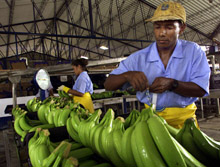
Typical street scene in Santa Ana, El Salvador. (Photo: iStock)
IMF Survey: Doing Well, Latin America Should Rebuild Buffers
April 20, 2012
- Region facing tailwinds of easy external financing and high commodity prices
- Favorable external conditions could lead to overheating
- Latin American economies need to rebuild buffers before risks materialize
Despite a somewhat weaker and still risky global economic outlook, the double tailwinds of easy external financing and high commodity prices are likely to persist for a while in Latin America—but not forever—said Nicolás Eyzaguirre, head of the IMF’s Western Hemisphere Department.

Worker at a banana factory in Uraba, Colombia. Easy external financing and high commodity prices are posing challenges for many countries in the region (photo: Luis Acosta/Newscom)
IMF-World Bank Spring Meetings
“In the context where much of the region is operating near or above potential, and where high commodity prices and easy external financing conditions continue to provide tailwinds, active policies are necessary to ensure the projected moderation in activity in the region,” Eyzaguirre said April 20 at a press briefing held as part of the IMF-World Bank Spring Meetings.
At the same time, Eyzaguirre noted that this stimulative environment creates opportunities for Latin America—“opportunities to build on the resilience and flexibility that has served the region so well in the past few years.”
Growth in Latin America remains solid, although it slowed somewhat during the second half of 2011 as a result of the combined effects of policy tightening and global uncertainties. Output in the region expanded by 4½ percent in 2011 and is expected to moderate somewhat in 2012, Eyzaguirre said.
Double tailwinds
The double tailwinds of easy external financing and high commodity prices that have supported many economies in Latin America remain present for much of the region. Monetary policy in advanced countries is likely to remain accommodative for some time. “This means that external financing will continue to be abundant and cheap,” Eyzaguirre said.
Meanwhile, sustained demand from emerging Asia will support commodity prices, keeping terms of trade high for South America’s commodity exporters. “These could fuel domestic demand and credit if policies are not appropriately adjusted,” he noted.
That said, Eyzaguirre pointed out that conditions will remain less favorable for the tourism- and remittances-dependent economies in Central America and the Caribbean, where external demand is more strongly linked to advanced economies.
Eyzaguirre recognized that countries with financial ties to Europe could be adversely affected by heightened tensions in Europe, although financial spillovers would be mitigated by the fact that most European bank subsidiaries in the region are well capitalized and domestically funded.
Policies to enhance resilience
Eyzaguirre stressed that Latin America should take advantage of still-favorable conditions to rebuild resilience and flexibility.
The more financially open commodity exporters, where output gaps have closed, should continue to regain fiscal space and preserve hard-won fiscal credibility. This would reduce the burden on monetary policy and grant it the needed flexibility to fine tune the cycle, Eyzaguirre explained. Meanwhile, these countries should preserve exchange rate flexibility to buffer shocks, and use macroprudential policies as a complement to address financial risks. In case of further bouts of instability, countries will need to pay close attention to liquidity conditions.
A number of other commodity exporters need to stop procyclical policies, which are exacerbating overheating pressures, eroding buffers, and weakening the balance of payments. “These countries need to start saving the commodity windfall, since high commodity prices will not last forever,” Eyzaguirre said.
Countries in Central America, which are operating near potential and have debt-to-GDP ratios above precrisis levels, should redouble efforts to consolidate their fiscal positions, while strengthening monetary and prudential policies.
Eyzaguirre noted that many Caribbean countries need to remain focused on working down fiscal overhangs and financial fragilities, given the threats they pose to stability.
The IMF’s Regional Economic Outlook for the Western Hemisphere will be published on April 25.







